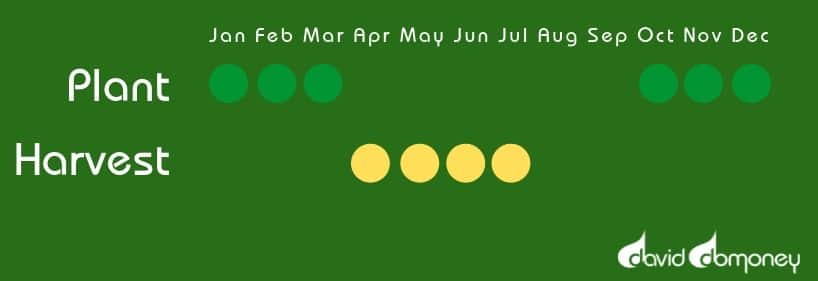Rhubarb is one of the easiest edible plants to grow. It’s frost-resistant and doesn’t need much care and attention. You can grow rhubarb from seed, but it’s much easier to plant a dormant crown. These are taken from strong plants and will establish faster. Alternatively you can buy pot-grown rhubarb.
Rhubarb will grow happily in a container, but it has a large root system and will need a deep pot.
Planting
- Prepare the soil by digging in plenty of organic matter like compost or well-rotted manure
- Dig a hole wider than the crown. Spread out the roots and plant so the tip of the crown is just above the soil level
- Fill in the hole with soil and water well
- If planting pot-grown rhubarb, plant as above and keep well-watered
How to look after me
Soil: Moist but well-drained
Position: Sunny
Location: Outdoors, container
David’s Top Tip
If you already have rhubarb in your garden, why not try forcing it? Clear the ground of weeds in late winter and cover the plant with a large pot or dustbin to block out all the light. It should be ready to harvest eight weeks later. Never force a plant two years in a row as it weakens the crown.


Growing
- In spring, remove the flowers as they appear. That way the rhubarb will put all its energy into producing tasty stems, instead of making seeds
- Boost plants with a general fertiliser in spring
- Keep the soil clear of weeds
- Apply a mulch of well-rotted manure or other rich organic matter to the soil. Keep the mulch clear of the crown to avoid crown rot
- Water rhubarb during dry spells to make sure the soil doesn’t dry out
- Watering is especially important for rhubarb in containers
- When the leaves die back naturally in autumn, cut the old stalks back to expose the buds, and apply a layer of mulch
- Every five or so years, lift and divide the crowns into three or four smaller plants
- If you don’t divide large plants, they will become congested and produce less stems
Harvesting
- Harvest rhubarb when the leaves have fully unfurled and the stems are around 30cm long
- Hold the stem at the base and pull it gently but firmly away from the crown. Do not bend or the stem may snap
- Do not remove many stems in the first year after planting while the rhubarb gets established
- Only harvest a few stems at once, and beware overcropping – it will reduce the plant’s vigour
- Stop harvesting in July to allow the plant to rebuild its energy stores before the autumn

Did You Know?
Strictly speaking, rhubarb is a vegetable and not a fruit! It’s related to the buckwheat family.

Leave A Comment